Last September my now 14-year-old papillon, Kitsune, was diagnosed with cervical IVDD. I posted a whole series of articles going over his 8-week recovery. I hope that reading about Kitsune’s recovery gives hope to other dog guardians who are dealing with a new IVDD diagnosis. Because as I sadly know firsthand, it’s a pretty stressful health condition to help your dog through. Despite posting quite a bit about IVDD and our experiences with it, I never actually went into detail about what, exactly, IVDD is. Until now!

- Kitsune’s IVDD Diary Week 1
- Kitsune’s IVDD Diary Week 2
- Kitsune’s IVDD Diary Week 3
- Kitsune’s IVDD Diary Week 4
- Kitsune’s IVDD Diary Weeks 5 & 6
- Kitsune’s IVDD Diary Weeks 7 & 8
Post Contents:
Intervertebral Disc Disease
IVDD is short for intervertebral disc disease. It is, basically, equivalent to what would be called a slipped, bulging, ruptured, or herniated disc in humans. IVDD is the most common spinal disease seen in dogs. Thousands of dogs are diagnosed with IVDD yearly. Sadly, once a dog is diagnosed with IVDD the chances that they will experience another occurrence or flare up sometime during their life is high.
So What, Exactly, is IVDD?
Dogs have cushioning (intervertebral) discs that sit in between the vertebrae, just below the spinal cord. These discs are each made of a fibrous outer layer, and an inner layer that has a jelly like consistency. When healthy, these discs act as shock absorbers. They prevent the vertebrae from rubbing together and help to protect the spinal cord. Sounds like a pretty important job right?
It is! Dogs’ spinal cords, like humans, are made up of delicate nervous tissue that transmits signals back and forth between the brain and the rest of the body. The spinal cord is responsible for everything from conscious movement to unconscious bodily functions such as breathing.
When problems occur in dogs’ intervertebral discs it can be, as you can imagine, a big problem. This is mostly due to their proximity to the spinal cord. There are three types of IVDD, all of which cause problems by impacting a dog’s spinal cord and/or the sensitive nerve roots that branch out from the spinal cord. The three types are called Hansen type I, Hansen type II, and Hansen type III.
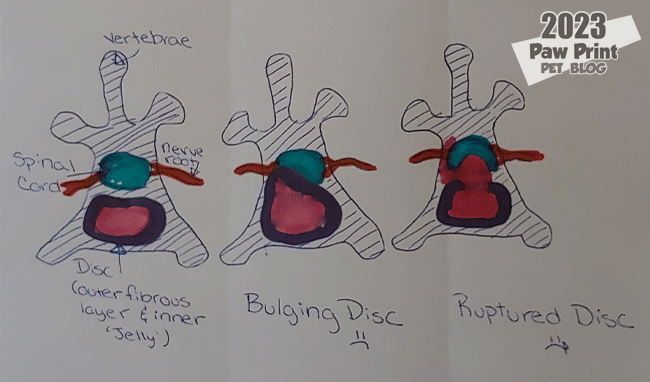
Hansen Type I IVDD (Ruptured Discs)
Hansen type I IVDD can be thought of as a ruptured disc. Your vet may also refer to it as a disc extrusion or herniation. This type of IVDD is more common in long backed and small breed dogs, and can sometimes occur even in younger dogs. In this type of IVDD, the “jelly” inside a dog’s disc becomes harder than normal. In this hardened state, it doesn’t move and compress normally. Because of this, normal movements, such as jumping on or off furniture, for example, can put enough stress on the hardened intervertebral disc that the jelly like center of the disc ruptures through the fibrous outer layer. Once the disc ruptures, the inner jelly can press against the spinal cord and/or surrounding nerve roots.
Hansen Type II IVDD (Bulging Discs)
Hansen type II IVDD can be thought of more as a bulging disc. In this type of IVDD, the disc does not rupture but instead bulges up against the spinal cord. Dogs with this type of IVDD may show a progression of symptoms more slowly over time rather than suddenly.
Hansen Type III IVDD (Traumatic IVDD)
Type III IVDD is caused by a sudden tear in the outer fibrous disc layer that can be caused by a traumatic event or very heavy exercise. In this type of IVDD, disc material essentially shoots out of the disc space into the spinal cord at a high velocity. Unlike the other types of IVDD, type III does not cause ongoing spinal cord compression. However, it can cause bruising of the spinal cord that can cause pain and other symptoms similar to the other two types of IVDD.
Diagnosing IVDD
Depending on what type of testing your vet uses to diagnose your dog with IVDD, they may not be able to tell you what type your dog has. Actually being able to tell whether your dog has a bulging disc, a ruptured disc, or experienced a traumatic injury with no ongoing spinal compression usually requires either a CT scan or an MRI. Because these types of imaging can be quite expensive, many vets will make a more general IVDD diagnoses (without knowing the exact type) without doing extensive imaging.
IVDD is often diagnosed based on symptoms, physical exams, less costly diagnostic testing such as Xray’s, and basic neurological exams. More expensive testing options, usually MRIs, are often reserved for dogs who will undergo spinal surgery to treat their IVDD.
Your vet may tell you that your dog has cervical IVDD, like my dog Kitsune did. This means that the disc causing issues for your dog is located in his/her neck rather than their back. Dogs with cervical IVDD often experience more intense symptoms of pain, due to the fact that the neck is a highly mobile area. Whether or not your vet tells you what type (I, II, or III) of IVDD your dog has, they should be able to tell you what stage he/she is at based on symptoms and a neurological exam.
The stages of IVDD are as follows:
- Stage 1: Dogs with stage 1 IVDD will generally experience pain but no loss of mobility. Dogs with stage 1 IVDD will be able to walk and stand relatively normally but may show signs of pain. These signs can include stiffer than normal movement, a reluctance to move their head (especially with cervical IVDD), holding their heads low, reluctance to move, hunched back, reluctance to eat or drink (especially out of a bowl placed low), shaking, etc.
- Stage 2: Dogs with stage 2 IVDD will show slight neurological deficits and usually more severe pain. Dogs with stage 2 IVDD will be able to walk but may appear weak, especially in the hind limps, or wobbly. Paw knuckling (dragging or walking on the knuckles of their paws) is common in dogs with stage 2 IVDD.
- Stage 3: Dogs with stage 3 IVDD with have more severe neurological deficits. Dogs at this stage will still be able to move their legs, but will not be able to walk independently without falling over. Paw knuckling while standing or walking assisted is very common.
- Stage 4: Dogs with stage 4 IVDD will be experience complete paralysis, but will maintain deep pain sensation. This means that while they will not be able to walk or move their legs, they will respond to their toes being pinched. Dogs at this stage may also lose control of their bladder and bowels.
- Stage 5: Dogs with stage 5 IVDD will also be paralyzed, and will no longer feel deep pain sensation.
There is Hope!

No matter the type, no matter the stage, IVDD is a stressful diagnoses to deal with. It can be easy to feel discourage when your dog is in extreme pain, potentially paralyzed, and your vet tells you that the cause involves his/her spinal cord. It’s important to remember that there is hope! Once upon a time it was more likely for dogs diagnosed with IVDD to be euthanized. But, these days, countless dogs are not only surviving IVDD, but thriving after their diagnoses. My Kitsune is one of them!
IVDD recovery is long, and it isn’t always easy. But in many cases, it is very much worth it! Speaking for myself, caring for Kitsune while he healed from his cervical IVDD was really stressful. I hate seeing my dogs in pain! He, thankfully, didn’t require surgery. But the price for conservative treatment, for multiple vet visits, diagnostic testing, and medications, can add up too. Making sure he rested strictly for 8 weeks wasn’t easy, especially once he started feeling better and resenting being cooped up. But everything – the money, the time, the stress, was worth it in the end to see my Kitsune feeling better and happy after his recovery!
I know there’s so much I didn’t go over in this post. All the symptoms of IVDD, treatment options, etc. I’m going to save those for another day. You can check out this link to read all our IVDD related posts. It will update in the future as I add more IVDD related content. And I’ll leave this post off with this. If you’re reading this because you’re facing an IVDD diagnoses with your beloved dog please remember that there is hope! There are options. IVDD does not have to be a death sentence!
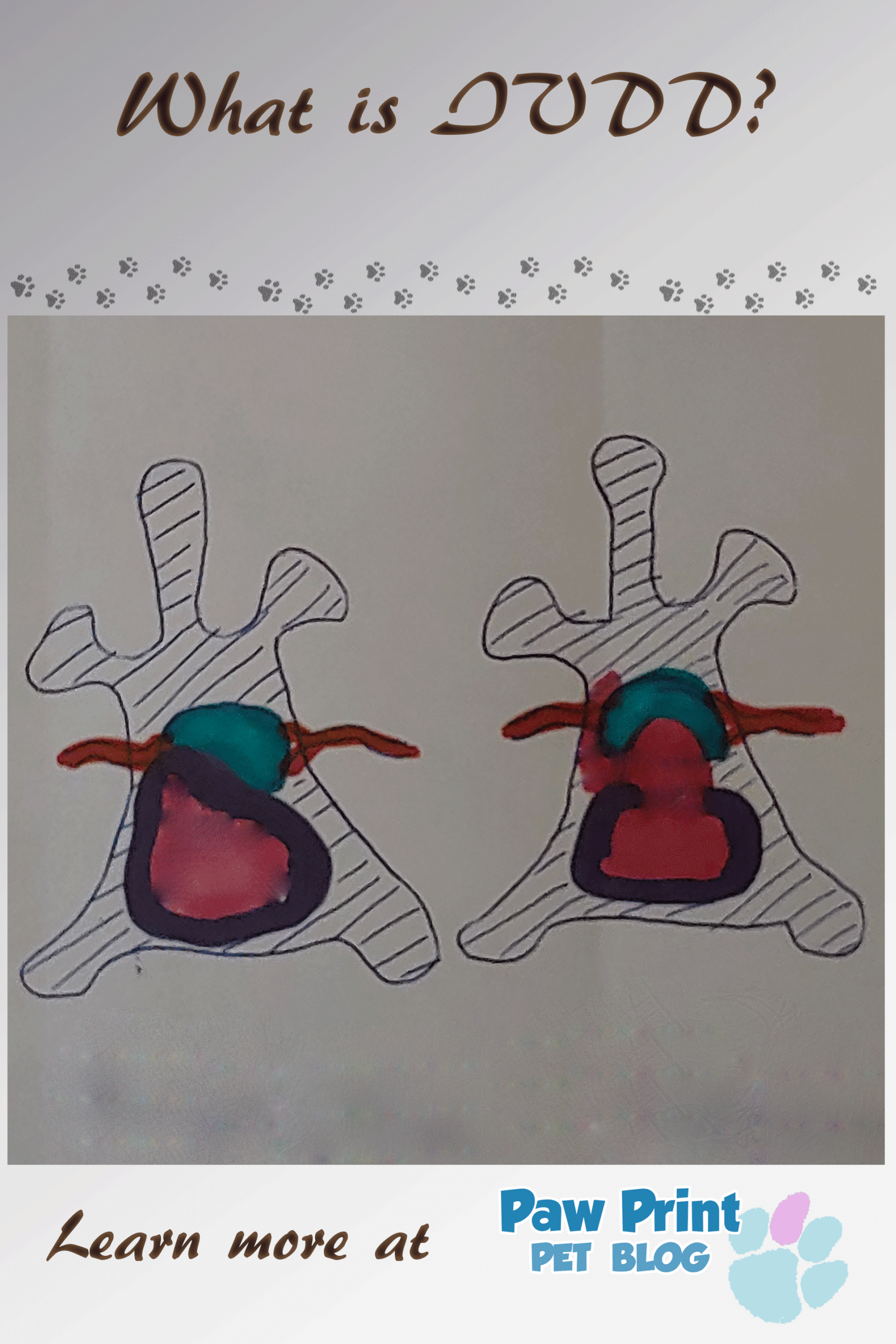

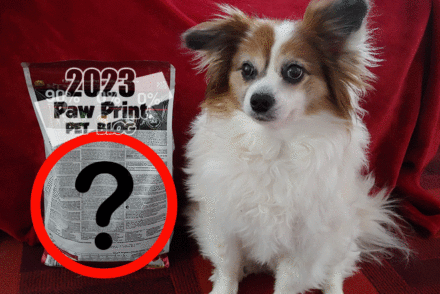
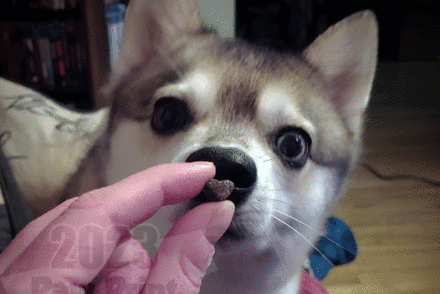
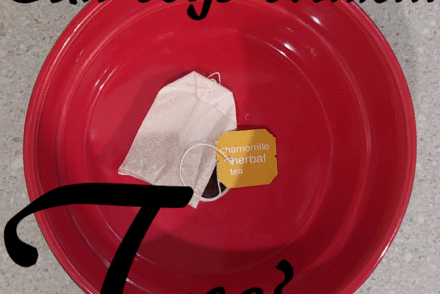

1 Comment
[…] What is IVDD […]